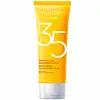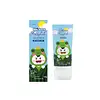What's inside
What's inside
 Key Ingredients
Key Ingredients

 Benefits
Benefits

 Concerns
Concerns

 Ingredients Side-by-side
Ingredients Side-by-side

Alcohol
AntimicrobialTocopherol
AntioxidantPantothenic Acid
Skin ConditioningWater
Skin ConditioningEthylhexyl Methoxycinnamate
UV AbsorberButyloctyl Salicylate
Skin ConditioningButyl Methoxydibenzoylmethane
UV AbsorberOctocrylene
UV AbsorberPropylene Glycol
HumectantHydroxyethyl Acrylate/Sodium Acryloyldimethyl Taurate Copolymer
Emulsion StabilisingTocopheryl Acetate
AntioxidantPhenoxyethanol
PreservativeSodium Acrylates Copolymer
Chlorphenesin
AntimicrobialPropanediol
SolventLecithin
EmollientAllantoin
Skin ConditioningPanthenol
Skin ConditioningDisodium EDTA
Parfum
MaskingEthylhexylglycerin
Skin ConditioningArtemisia Capillaris Flower Extract
Skin ConditioningAlcohol, Tocopherol, Pantothenic Acid, Water, Ethylhexyl Methoxycinnamate, Butyloctyl Salicylate, Butyl Methoxydibenzoylmethane, Octocrylene, Propylene Glycol, Hydroxyethyl Acrylate/Sodium Acryloyldimethyl Taurate Copolymer, Tocopheryl Acetate, Phenoxyethanol, Sodium Acrylates Copolymer, Chlorphenesin, Propanediol, Lecithin, Allantoin, Panthenol, Disodium EDTA, Parfum, Ethylhexylglycerin, Artemisia Capillaris Flower Extract
Water
Skin ConditioningOctocrylene
UV AbsorberEthylhexyl Salicylate
UV AbsorberButylene Glycol
HumectantButyl Methoxydibenzoylmethane
UV AbsorberDicaprylyl Carbonate
EmollientArachidyl Alcohol
EmollientBehenyl Alcohol
EmollientArachidyl Glucoside
EmulsifyingDimethicone
EmollientPolysorbate 60
EmulsifyingTocopheryl Acetate
AntioxidantPolymethylsilsesquioxane
Vp/Hexadecene Copolymer
Panthenol
Skin ConditioningAcrylates/C10-30 Alkyl Acrylate Crosspolymer
Emulsion StabilisingMethyl Gluceth-20
HumectantXanthan Gum
EmulsifyingAllantoin
Skin ConditioningChlorphenesin
AntimicrobialAminomethyl Propanol
BufferingDisodium EDTA
Astragalus Membranaceus Root Extract
EmollientAtractylodes Macrocephala Rhizome Extract
Skin ConditioningLedebouriella Divaricata Root Extract
Skin ConditioningChamomilla Recutita Flower Extract
MaskingAlbizia Julibrissin Bark Extract
MaskingGlycyrrhiza Glabra Root Extract
BleachingGlycerin
Humectant1,2-Hexanediol
Skin ConditioningHydroxyacetophenone
AntioxidantPhenoxyethanol
PreservativeEthylhexylglycerin
Skin ConditioningRosa Damascena Flower Oil
MaskingCinnamomum Camphora Leaf Extract
MaskingCitrus Aurantium Bergamia Fruit Oil
MaskingCitrus Aurantium Amara Flower Oil
MaskingIris Florentina Root Extract
MaskingWater, Octocrylene, Ethylhexyl Salicylate, Butylene Glycol, Butyl Methoxydibenzoylmethane, Dicaprylyl Carbonate, Arachidyl Alcohol, Behenyl Alcohol, Arachidyl Glucoside, Dimethicone, Polysorbate 60, Tocopheryl Acetate, Polymethylsilsesquioxane, Vp/Hexadecene Copolymer, Panthenol, Acrylates/C10-30 Alkyl Acrylate Crosspolymer, Methyl Gluceth-20, Xanthan Gum, Allantoin, Chlorphenesin, Aminomethyl Propanol, Disodium EDTA, Astragalus Membranaceus Root Extract, Atractylodes Macrocephala Rhizome Extract, Ledebouriella Divaricata Root Extract, Chamomilla Recutita Flower Extract, Albizia Julibrissin Bark Extract, Glycyrrhiza Glabra Root Extract, Glycerin, 1,2-Hexanediol, Hydroxyacetophenone, Phenoxyethanol, Ethylhexylglycerin, Rosa Damascena Flower Oil, Cinnamomum Camphora Leaf Extract, Citrus Aurantium Bergamia Fruit Oil, Citrus Aurantium Amara Flower Oil, Iris Florentina Root Extract
Ingredients Explained
These ingredients are found in both products.
Ingredients higher up in an ingredient list are typically present in a larger amount.
Allantoin is a soothing ingredient known for its protective and moisturizingg properties. Because of this, it is often added to products with strong active ingredients.
Studies show higher concentrations of this ingredient can promote wound healing.
Though it can be derived from the comfrey plant, allantoin is produced synthetically for cosmetic products to ensure purity.
Learn more about AllantoinAlso known as Avobenzone, this ingredient is a chemical sunscreen filter that provides protection in the UV-A range.
Avobenzone is globally approved and is the most commonly used UV-A filter in the world.
Studies have found that avobenzone becomes ineffective when exposed to UV light (it is not photostable; meaning that it breaks down in sunlight). Because of this, formulations that include avobenzone will usually contain stabilizers such as octocrylene.
However, some modern formulations (looking at you, EU!) are able to stabilize avobenzone by coating the molecules.
Avobenzone does not protect against the UV-B range, so it's important to check that the sunscreen you're using contains other UV filters that do!
The highest concentration of avobenzone permitted is 3% in the US, and 5% in the EU.
Learn more about Butyl MethoxydibenzoylmethaneChlorphenesin is a synthetic preservative. It helps protect a product against bacteria in order to extend shelf life. In most cases, Chlorphenesin is paired with other preservatives such as phenoxyethanol and caprylyl glycol.
Chlorphenesin is a biocide. This means it is able to help fight the microorganisms on our skin. It is also able to fight odor-releasing bacteria.
Chlorphenesin is soluble in both water and glycerin.
Studies show Chlorphenesin is easily absorbed by our skin. You should speak with a skincare professional if you have concerns about using Chlorphenesin.
Learn more about ChlorphenesinDisodium EDTA plays a role in making products more stable by aiding other preservatives.
It is a chelating agent, meaning it neutralizes metal ions that may be found in a product.
Disodium EDTA is a salt of edetic acid and is found to be safe in cosmetic ingredients.
Learn more about Disodium EDTAEthylhexylglycerin (we can't pronounce this either) is commonly used as a preservative and skin softener. It is derived from glyceryl.
You might see Ethylhexylglycerin often paired with other preservatives such as phenoxyethanol. Ethylhexylglycerin has been found to increase the effectiveness of these other preservatives.
Octocrylene protects skin from sun damage. It absorbs UV-B with peak absorption of 304 nm. It is a common sunscreen ingredient and often paired with avobenzone, a UVA filter. This is because octocrylene stabilizes other sunscreen ingredients by protecting them from degradation when exposed to sunlight. Octocrylene is a photostable ingredient and loses about 10% of SPF in 95 minutes.
Octocrylene also acts as an emollient, meaning it helps skin retain moisture and softens skin. It is oil-soluble and hydrophobic, enhancing water-resistant properties in a product.
Those who are using ketoprofen, a topical anti-inflammatory drug, may experience an allergic reaction when using octocrylene. It is best to speak with a healthcare professional about using sunscreens with octocrylene.
The EU allows a maximum of these concentrations:
Learn more about OctocrylenePanthenol is a common ingredient that helps hydrate and soothe the skin. It is found naturally in our skin and hair.
There are two forms of panthenol: D and L.
D-panthenol is also known as dexpanthenol. Most cosmetics use dexpanthenol or a mixture of D and L-panthenol.
Panthenol is famous due to its ability to go deeper into the skin's layers. Using this ingredient has numerous pros (and no cons):
Like hyaluronic acid, panthenol is a humectant. Humectants are able to bind and hold large amounts of water to keep skin hydrated.
This ingredient works well for wound healing. It works by increasing tissue in the wound and helps close open wounds.
Once oxidized, panthenol converts to pantothenic acid. Panthothenic acid is found in all living cells.
This ingredient is also referred to as pro-vitamin B5.
Learn more about PanthenolPhenoxyethanol is a preservative that has germicide, antimicrobial, and aromatic properties. Studies show that phenoxyethanol can prevent microbial growth. By itself, it has a scent that is similar to that of a rose.
It's often used in formulations along with Caprylyl Glycol to preserve the shelf life of products.
Tocopheryl Acetate is AKA Vitamin E. It is an antioxidant and protects your skin from free radicals. Free radicals damage the skin by breaking down collagen.
One study found using Tocopheryl Acetate with Vitamin C decreased the number of sunburned cells.
Tocopheryl Acetate is commonly found in both skincare and dietary supplements.
Learn more about Tocopheryl AcetateWater. It's the most common cosmetic ingredient of all. You'll usually see it at the top of ingredient lists, meaning that it makes up the largest part of the product.
So why is it so popular? Water most often acts as a solvent - this means that it helps dissolve other ingredients into the formulation.
You'll also recognize water as that liquid we all need to stay alive. If you see this, drink a glass of water. Stay hydrated!
Learn more about Water